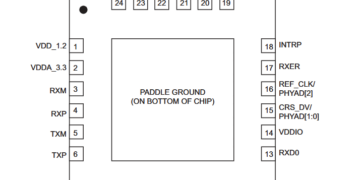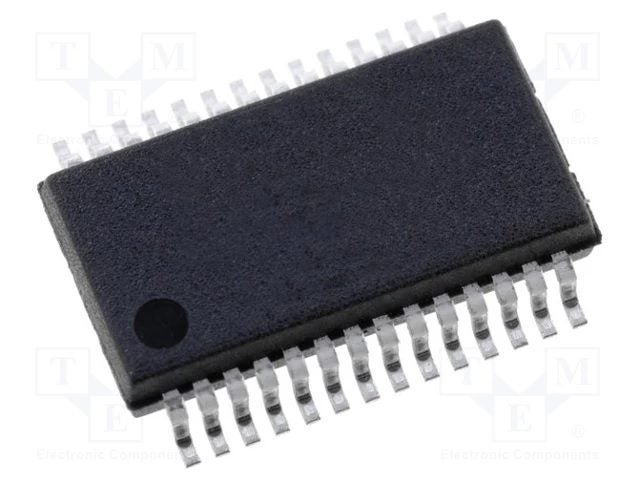
FT232RL UART to USB Chip. Image from TME.
You probably recall seeing advertisements over various mediums—including the internet—where a technician would repeatedly ask, “Can you hear me now?” A well-known cell phone company used this phrase to point out the quality and range of their telecommunications service. The advertisement specifically shows wireless mobile communication; however, it highlights the fact that clarity at the receiver is critical for all data communications—at all levels and over all channels.
The foundation for any digital communication system is the ability to convert inputs into a transferable format that can be identified and understood by the receiving system. Data may be created from a myriad of different sources. Therefore, quality electronic components that perform signal processing; including data conversion, are essential to effectively communicate data. One component, commonly used to convert from UART to USB, is described in the FT232RL datasheet.
Common Applications for the FT232RL Chip
By far the most common connector for digital communication is USB. Therefore, the ability to convert to and from USB is almost mandatory for systems that include computing and networking equipment. This requirement has led to the development of devices to allow various devices to “talk” via USB connectivity. One component that is popular with engineers and PCBA designers is the FT232R.
The FT232R is a single chip USB converter for universal asynchronous receiver-transmitter (UART) data transfer. The SoC is typically used as follows:
FT232RL Applications
- ☐ Update older systems to USB
- ☐ Modems
- ☐ Cellular phone cables
- ☐ Bar code readers
- ☐ Dongles for encryption
- ☐ Integrating high performance modules (e.g. MCUs, FPGAS, PDAs)
- ☐ Bluetooth audio and video systems
- ☐ Digital cameras
- ☐ Industrial controllers
- ☐ MP3 players
- ☐ Flash card read/write
- ☐ Smart card readers
As the list above illustrates, the FT232R is used in a wide range of applications. However, it is most often used as a converter for USB to RS232, RS422 or RS485, which is discussed in detail in the FT232RL datasheet.
Exploring the FT232RL Datasheet
As the datasheet stipulates, the FT232R comes with a plethora of features, listed below, to ease the conversion of data signals between different devices.
Features of the FT232R USB Converter
- ❖ Single chip USB to asynchronous serial data transfer interface
- ❖ Entire USB protocol handled on the chip; no USB-specific firmware programming required
- ❖ Fully integrated 1024 bit EEPROM storing device descriptors and CBUS I/O configuration
- ❖ Fully integrated USB termination resistors
- ❖ Fully integrated clock generation with no external crystal required plus optional clock output selection enabling a glue-less interface to external MCU or FPGA
- ❖ Data transfer rates from 300 baud to 3 Mbaud (RS422, RS485, RS232) at TTL levels
- ❖ 128 byte receive buffer and 256 byte transmit buffer utilising buffer smoothing technology to allow for high data throughput
- ❖ FTDI’s royalty-free Virtual Com Port (VCP) and Direct (D2XX) drivers eliminate the requirement for USB driver development in most cases
- ❖ Unique USB FTDIChip-IDTM feature
- ❖ Configurable CBUS I/O pins
- ❖ Transmit and receive LED drive signals
- ❖ UART interface support for 7 or 8 data bits, 1 or 2 stop bits and odd / even / mark / space / no parity FIFO receives and transmits buffers for high data throughput
- ❖ Synchronous and asynchronous bit bang interface options with RD# and WR# strobes
- ❖ Device supplied pre-programmed with unique USB serial number
- ❖ Supports bus-powered, self-powered, and high-power bus-powered USB configurations.
- ❖ Integrated +3.3V level converter for USB I/O
- ❖ Integrated level converter on UART and CBUS for interfacing to between +1.8V and +5V logic
- ❖ True 5V/3.3V/2.8V/1.8V CMOS drive output and TTL input
- ❖ Configurable I/O pin output drive strength
- ❖ Integrated power-on-reset circuit
- ❖ Fully integrated AVCC supply filtering – no external filtering required
- ❖ UART signal inversion option
- ❖ +3.3V (using external oscillator) to +5.25V (internal oscillator) Single Supply Operation
- ❖ Low operating and USB suspend current
- ❖ Low USB bandwidth consumption
- ❖ UHCI/OHCI/EHCI host controller compatible
- ❖ USB 2.0 Full Speed compatible
- ❖ -40°C to 85°C extended operating temperature range
- ❖ Available in compact Pb-free 28 Pin SSOP and QFN-32 packages (both RoHS compliant)
The converter includes an integrated EEPROM, internal clock generation, termination resistors, and is fully USB 2.0 compliant.
Functions and Operation
The block diagram for the FT232R is below.
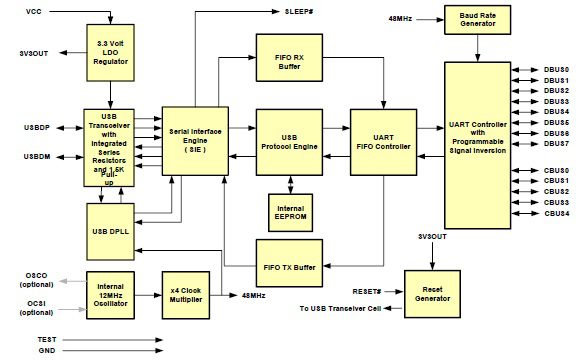
Functions of the FT232RL
As shown, the converter has a UART FIFO Controller and UART Controller with signal inversion programmability. The TX Buffer is 256 bytes and the RX Buffer is 128 bytes. USB serial to parallel and parallel to serial conversion is handled by the Serial Inversion Engine (SIE). The EEPROM is pre-programmed, but can be modified by downloading the FT PROG software. Important characteristics and specifications are given below.
Specifications and Characteristics
The parameters which bound the operation of the FT232R are listed in the table below.
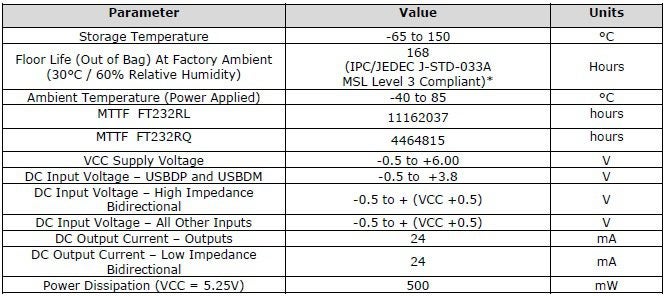
Maximum ratings for the FT232RL
The DC characteristics are below.

FT232RL DC characteristics
The FT232RL datasheet provides additional specs for various operating conditions, as well as several application examples.
Example Applications
In the datasheet, there are example circuits for using the FT232R to convert from USB to RS232, RS422, RS485, and MCU UART interface. The circuit for the RS485 conversion is shown below.
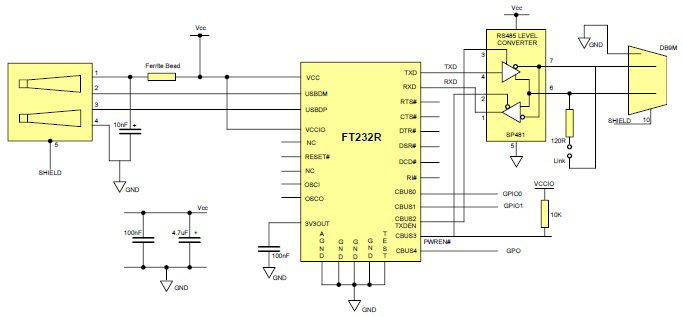
USB to RS485 conversion with the FT232RL
There are several FT232R configurations available for the device and alternative components.
Other FT232R Configurations
- ➞ FT232R 32-pin QFN, 28-pin SSOP
- ➞ FT234XD 12-pin DFN
- ➞ FT230X 16-pin QFN, 16-pin SSOP
- ➞ FT231X 20-pin QFN, 20-pin SSOP
- ➞ FT232H 48-pin QFN, 48-pin LQFP
Alternative Parts
- ➢ TUSB3410VF (Texas Instruments)
PCBA Design with the FT232R
The FT232RL datasheet is extensive. The document contains very important data and information that should be utilized when implementing the device. This includes landing patterns that will aid you when creating your own footprints. However, the best option is to utilize verified models from an online electronic components library as is shown below.
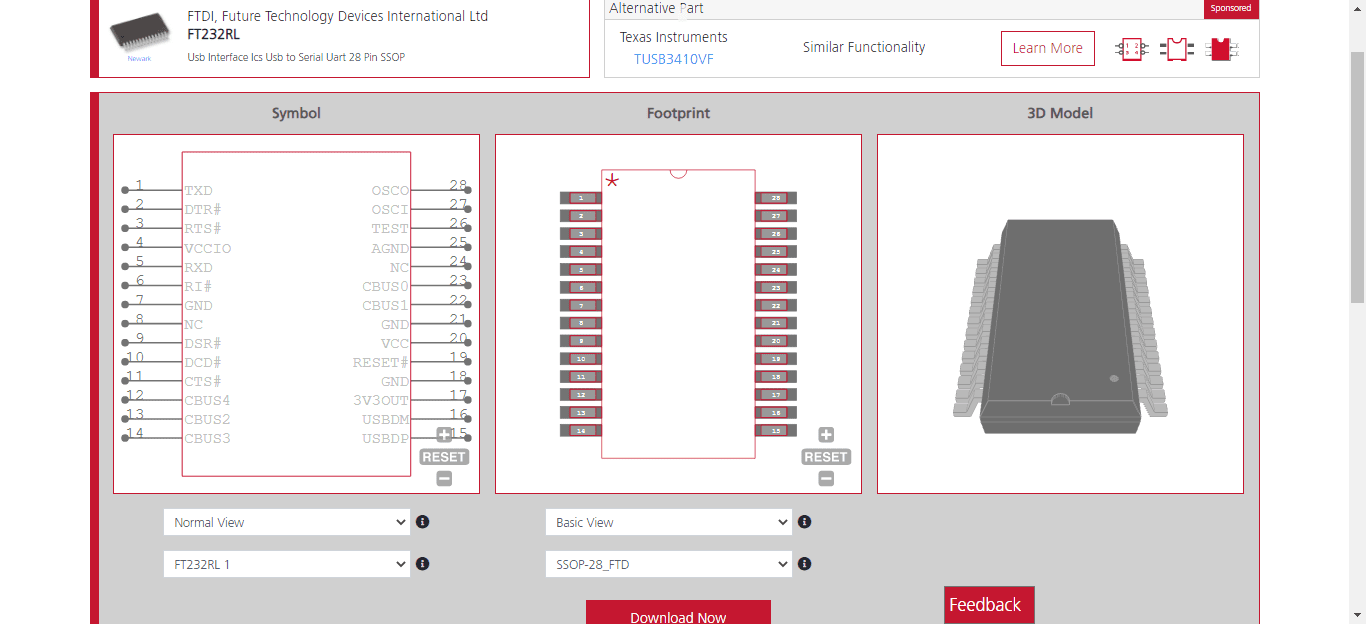
CAD data for the FT232RL from UL
As shown above, UL provides CAD data for your schematic, PCB layout and 3D simulations, and ECAD/MCAD integration.
If you’re looking for CAD models for common components or design data and information; such as the FT232RL datasheet, Ultra Librarian helps by compiling all your sourcing and CAD information in one place. Working with Ultra Librarian sets up your team for success to ensure streamlined and error-free design, production, and sourcing. Register today for free.



